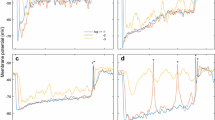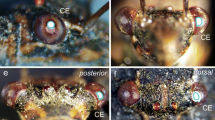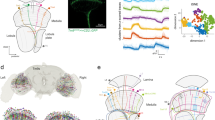Summary
The synaptic relationships between and within receptor-cell axons (RCAs), first-order interneurones (L-fibres) and accessory fibres (acc) in the first optic ganglion (the lamina) of the worker bee were studied in serial sections with Golgi-EM and routine transmission electron microscopy. The ommatidium contains nine retinular (photoreceptor) cells all of which project as RCAs to a single optical cartridge in the lamina. Six of the RCAs end as short visual fibres (svf) in the lamina, while the remaining three, the so-called long visual fibres (lvf), pass the lamina and end in the second optic ganglion, the medulla. In addition to the RCAs and an unknown number of accessory fibres, the cartridge also contains four L-fibres (L 1–4). The spatial arrangement of the RCAs and L-fibres within a cartridge is constant throughout the depth of the lamina. Serial sections reveal a great number of chemical synapses interconnecting RCAs, L-and acc fibres. Double T-shaped presynaptic dense projections are surrounded and in close association with either spherical or flattened synaptic vesicles. The finding of gap junctions between and within identified RCAs and L-fibres suggest that these axons may be electronically coupled. A model for information processing in the lamina of the bee is suggested from observations of synaptic connectivity between and within fibres of one cartridge.
Similar content being viewed by others
References
Akert K, Sandri C (1970) Identification of the active region by means of histochemical and freezeetching techniques. In: Anderson P and Hansen JKS (eds) Excitatory synaptic mechanisms. Universitetsforlaget, Oslo, pp 27–41
Armett-Kibel C, Meinertzhagen IA, Dowling JE (1977) Cellular and synaptic organization in the lamina of the dragonfly Sympetrum rubicundulum. Proc R Soc Lond B 196:385–413
Arnett DW (1971) Receptive field organization of units in the first optic ganglion of Diptera. Science 173:929–931
Arnett DW (1972) Spatial and temporal integration of units in the first optic ganglion of dipterans. J Neurophysiol 35:429–444
Autrum H, Zwehl V v (1964) Die spektrale Empfindlichkeit einzelner Sehzellen des Bienenauges. Z vergl Physiol 48:357–384
Boeckh J, Sandri C, Akert K (1970) Sensorische Eingänge und synaptische Verbindungen im Zentralnervensystem von Insekten. Z Zellforsch 103:429–446
Boschek CB (1971) On the fine structure of the peripheral retina and lamina ganglionaris of the fly Musca domestica. Z Zellforsch 118:369–409
Braitenberg V (1967) Patterns of projection in the visual system of the fly. I. Retina-lamina projections. Exp Brain Res 3:271–298
Braitenberg V, Strausfeld NJ (1973) Principles of the mosaic organization in the visual system's neuropil f Musca domestica L. In: Jung R (ed) Handbook of Sensory Physiology. Berlin Heidelberg New York, Springer, Vol VII/3A
Burkhardt W, Braitenberg V (1976) Some peculiar synaptic complexes in the visual ganglion of the fly, Musca domestica. Cell Tissue Res 173:287–308
Cajal RS, Sánchez D (1915) Contribución al conocimiento de los centros nerviosos de los insectos. Trab Lab Invest Biol Univ Madrid 13:1–164
Campos-Ortega JA, Strausfeld NJ (1973a) The L-4 monopolar neuron: a substrate for lateral interaction in the visual system of the fly Musca domestica. Brain Res 59:97
Campos-Ortega JA, Strausfeld NJ (1973b) Synaptic connections of intrinsic cells and basket arborizations in the external plexiform layer of the fly's eye. Brain Res 59:119–136
Chi C, Carlson DS (1976) Close apposition of photoreceptor cell axons in the house fly. J Insect Physiol 22:1153–1157
Chi C, Carlson DS (1980) Membrane specializations in the first optic neuropil of the housefly Musca domestica. J Neurocytol 9:429–449
Destombes J, Gogan P, Rouviere A (1979) The fine structure of neurones and cellular relationships in the abducens nucleus in the cat. Exp Brain Res 35:249–267
Dowling JE (1968) Synaptic organization in the frog retina: an electron microscopic analysis comparing the retinas of frogs and primates. Proc R Soc Lond B 170:205–228
Dowling JE, Werblin FS (1969) Organization of the retina of the mudpuppy, Necturus maculosus. I. Synaptic structure. J Neurophysiol 32:315–338
Dowling JE, Chappell RL (1972) Neural organization of the median ocellus of the dragonfly II. Synaptic structure. J Genet Physiol 60:148–165
Franceschini N, Hardie R, Ribi WA, Kirschfeld K (1981) Sexual dimorphism in a photoreceptor. Nature (in press)
Goodman LJ (1970) The structure and function of the insect dorsal ocellus. In: Beament WL, Treherne JE, Wigglesworth VB (eds) Advances in Insect Physiology. Academic Press, London New York
Goodman LJ, Mobbs PG, Kirkham JB (1979) The fine structure of the ocelli of Schistocerca gregaria. Cell and Tissue Res 196:487–510
Gray EG, Pease HL (1971) On understanding the organization of the retinal receptor synapses. Brain Res 35:1–15
Gribakin FG (1969) Types of photoreceptor cells in the compound eye of the worker honey bee relative o their spectral sensivity. Cytologie (Tokyo) 11:309–314
Guy RG, Goodman LJ, Mobbs PJ (1977) Ocellar connections within the ventral nerve cord in the locust, Schistocerca gregaria: Electrical and anatomical characteristics. J Comp Physiol 115:337–350
Hertel H (1980) Chromatic properties of identified interneurons in the optic lobes of the bee. J Comp Physiol 137:215–231
Horridge GA, Meinertzhagen IA (1970) The exact neural projection of the visual fields upon the first and second ganglia of the insect eye. Z vergl Physiol 66:393–378
Jährvilehto M, Moring J (1974) Polarization sensivity of individual retinula cells and neurons of the fly Calliphora. J Comp Physiol 91:387–397
Jährvilehto M, Zettler F (1971) Localised intracellular potentials from pre- and postsynaptic components in the external plexiform layer of an insect retina. Z vergl Physiol 75:422–440
Kenyon FC (1896) The brain of the bee. A preliminary contribution to the morphology of the nervous system of the arthropoda. J Comp Neurol 6:133–210
Kien J, Menzel R (1977a) Chromatic properties of interneurons in the optic lobes of the bee. I. Broad band neurons. J Comp Physiol 113:17–34
Kien J, Menzel R (1977b) Chromatic properties of interneurons in the optic lobes of the bee. II. Narrow band and colour opponent neurons. J Comp Physiol 113:35–53
Korneliussen H (1972) Elongated profiles of synaptic vesicles in motor endplates. Morphological effects of fixative variations. J Neurocytol 1:279–296
Korneliussen H (1973) Ultrastructure of motor nerve terminals on different types of muscle fibers in the Atlantic hagfish (Myxine glutinosa L.). Occurrence of round and elongated profiles of synaptic vesicles and dense-core vesicles. Z Zellforsch 147:87–105
Laughlin SB (1973) Neural integration in the first optic neuropile of dragonflies. I. Signal amplification in the dark adapted second order neurones. J Comp Physiol 84:335–355
Melamed J, Trujillo-Cenoz O (1968) The fine structure of the central cell in the ommatidia of dipterans. J Ultrastruct Res 21:313–334
Menzel R (1974) Spectral sensivity of monopolar cells in the bee lamina. J Comp Physiol 93:337–346
Menzel R (1977) Farbsehen bei Insekten — ein rezeptorphysiologischer und neurophysiologischer Problemkreis. Verh Dtsch Zool Ges, 26–40, Gustav Fischer Verlag, Stuttgart
Menzel R, Snyder AW (1974) Polarized light detection in the bee, Apis mellifera. J Comp Physiol 88:247–270
Menzel R, Blakers M (1976) Colour receptors in the bee eye-morphology and spectral sensivity. J Comp Physiol 108:11–33
Meyer EP (1979) Golgi-EM-study of first and second order neurons in the visual system of Cataglyphis bicolor Fabricius (Hymenoptera, Formicidae). Zoomorph 92:115–139
Millonig G (1961) Advantages of a phosphate buffer for OsO4 solutions in fixation. J Appl Physiol 32:1637
Nässel DR, Elofsson R, Odselius R (1978) Neuronal connectivity patterns in the compound eyes of Artemia salina and Daphnia magna (Crustacea: Branchiopoda). Cell Tissue Res 100:435–457
Nüesch H, Stocker RF (1975) Ultrastructural studies on neuromuscular contacts and the formation of junctions in the flight muscle of Antheraea polyphemus (Lep.). II. Chances after motor nerve section. Cell Tissue Res 164:331–355
Pappas GD (1966) Electron microscopy of neuronal junctions involved in transmission in the CNS. In: Rodahl K (ed), Nerve as a Tissue. Harper and Row, New York
Protomastro JJ (1972) La retina intermedia de la abeja obrera (Apis mellifica L.). Physis 31:389–398
Ribi WA (1974) Neurons in the first synaptic region of the bee, Apis mellifera. Cell Tissue Res 148:277–286
Ribi WA (1975a) The neurons of the first optic ganglion of the bee, Apis mellifera. Advances in Anatomy 50:4 1–43
Ribi WA (1975b) The organization of the lamina ganglionaris of the bee. Z Naturforsch. 30c: 851–852
Ribi WA (1975c) The first optic ganglion of the bee. I. Correlation between visual cell types and their terminals in the lamina and medulla. Cell Tissue Res 165:103–111
Ribi WA (1976a) A Golgi-electron microscope method for insect nervous tissue. Stain Technol 51:13–16
Ribi WA (1976b) The first optic ganglion of the bee. II. Topographical relationships of second order neurons within a cartridge and to groups of cartridges. Cell Tissue Res 171:359–373
Ribi WA (1977) Fine structure of the first optic ganglion (lamina) of the cockroach, Periplaneta americana. Tissue and Cell 9:57–72
Ribi WA (1978a) A unique hymenopteran compound eye. The retina fine structure of the digger wasp Sphex cognatus Smith (Hymenoptera, Sphecidae). Zool Jb Anat 100:299–342
Ribi WA (1978b) Gap junctions coupling photo-receptor axons in the first optic ganglion of the fly. Cell Tissue Res 195:299–308
Ribi WA (1979) The first optic ganglion of the bee. III Regional comparison of photoreceptor cell axon morphology. Cell Tissue Res 200:345–357
Ribi WA, Berg GJ (1980) Light and electron microscopic structure of Golgi-stained neurons in the vertebrate brain (new rapid Golgi procedure). Cell Tissue Res 205:1–10
Schmidt B (1975) Die neuronale Organisation in den Ocellen von Drosophila. Dissertation, Albert-Ludwigs-Universität
Scholes J (1969) The electrical responses of the retinal receptors and the lamina in the visual system of the fly Musca. Kybernetik 6:149–162
Schürmann FW (1974) Bemerkungen zur Funktion der Corpora pedunculata im Gehirn der Insekten aus morphologischer Sicht. Exp Brain Res 19:406–432
Sjöstrand FS (1958) Ultrastructure of retinal rod synapses of guinea pig eye as revealed by three dimensional reconstructions from serial sections. J Ultrastruct Res 2:122–170
Snyder AW, Menzel R, Laughlin SB (1973) Structure and function of the fused rhabdom. J Comp Physiol 87:99–135
Steiger U (1967) Über den Feinbau des Neuropils im Corpus pedunculatum der Waldameise. Elektronenoptische Untersuchungen. Z Zellforsch 81:511–536
Strausfeld NJ (1970) Variations and invariants of cell arrangements in the nervous system of insects. In: Verh Dtsch Zool Ges 97–108, Gustav Fischer Verlag, Stuttgart
Strausfeld NJ (1971) The organisation of the insect visual system (light microscopy). I. Projections and arrangements of neurons in the lamina ganglionaris of diptera. Z Zellforsch 121:377–441
Strausfeld NJ, Campos-Ortega JA (1973) The L-4 monopolar neuron: a substrate for lateral interaction in the visual system of the fly, Musca domestica L. Brain Res 59:97–118
Strausfeld NJ, Campos-Ortega JA (1977) Vision in insects: Pathways possibly underlying neural adaption and lateral inhibition. Science 195:894–897
Tisdale AD, Nakajima Y (1973) Effects of osmolarity of fixatives on the fine structure of synaptic vesicles of nerve terminals in the crayfish stretch receptor. In: Society for Neuroscience, p 106. Third Annular Meeting
Toh Y, Kuwabara M (1974) Fine structure of the dorsal ocellus of the worker honeybee. J Morphol 143:285–306
Toh Y, Kuwabara M (1975) Synaptic organization of the fleshfly ocellus. J Neurocytol 4:271–287
Tredici G, Pizzini G, Milanesi S (1976) The ultrastructure of the nucleus of the oculomotor nerve (somatic efferent portion) of the cat. Anat Embryol 149:323–346
Trujillo-Cenoz O (1965) Some aspects of the structural organization of the intermediate retina of dipterans. J Ultrastruct Res 13:1–33
Trujillo-Cenoz O (1969) Some aspects of the structural organization of the medulla in muscoid flies. J Ultrastruct Res 27:533–553
Uchizono K (1965) Characteristics of the excitatory and inhibitory synapses in the central nervous system of the cat. Nature 207:642–643
Valdivia O (1971) Methods of fixation and the morphology of synaptic vesicles. J Comp Neurol 142:257–274
Varela FG (1970) Fine structure of the visual system of the honey bee (Apis mellifera). II. The lamina. J Ultrastruct Res 178–194
Vigier P (1908) Sur l'existence réelle et le rôle des appendices piriformes des neurones. Le neurone périoptique des Diptères. C R Soc Biol (Paris) 64:959–961
Zettler F, Järvilehto M (1972) Lateral inhibition in an insect eye. Z vergl Physiol 76:233–244
Author information
Authors and Affiliations
Rights and permissions
About this article
Cite this article
Ribi, W.A. The first optic ganglion of the bee. Cell Tissue Res. 215, 443–464 (1981). https://doi.org/10.1007/BF00233522
Accepted:
Issue Date:
DOI: https://doi.org/10.1007/BF00233522




